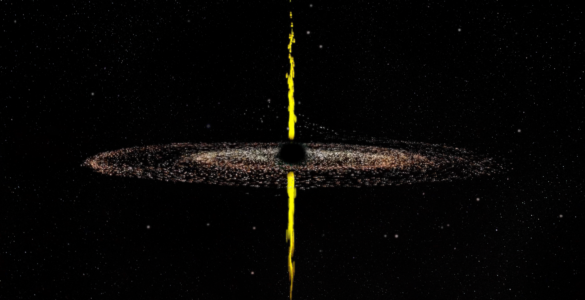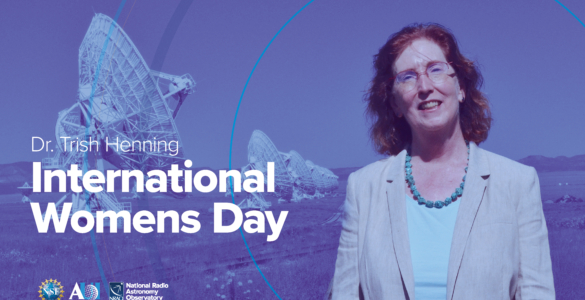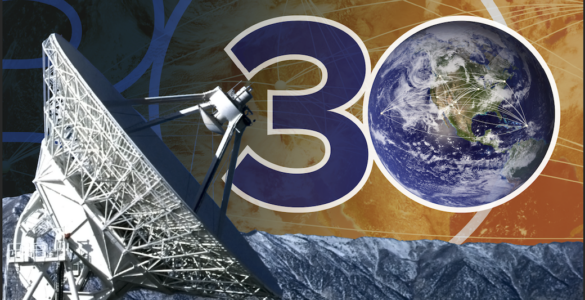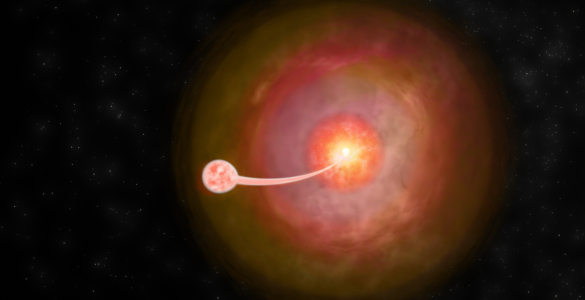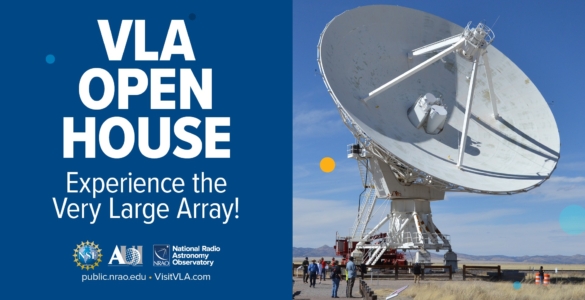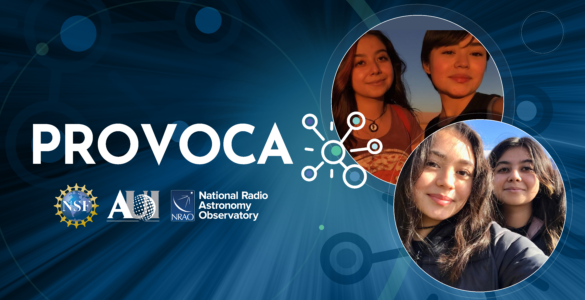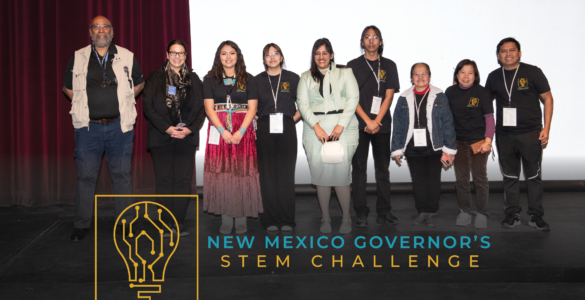NASA and the National Radio Astronomy Observatory are joining with an international consortium of space agencies to support the launch of a Japanese satellite next week that will create the largest astronomical “instrument” ever built — a radio telescope more than two-and-a-half times the diameter of the Earth that will give astronomers their sharpest view yet of the universe.
The launch of the Very Long Baseline Interferometry (VLBI) Space Observatory Program (VSOP) satellite by Japan’s Institute of Space and Astronautical Science (ISAS) is scheduled for Feb. 10 at 11:50 p.m. EST (1:50 p.m. Feb. 11, Japan time.)
The satellite is part of an international collaboration led by ISAS and backed by Japan’s National Astronomical Observatory; NASA’s Jet Propulsion Laboratory (JPL), Pasadena, CA; the National Science Foundation’s National Radio Astronomy Observatory (NRAO), Socorro, NM; the Canadian Space Agency; the Australia Telescope National Facility; the European VLBI Network and the Joint Institute for Very Long Baseline Interferometry in Europe.
Very long baseline interferometry is a technique used by radio astronomers to electronically link widely separated radio telescopes together so they work as if they were a single instrument with extraordinarily sharp “vision,” or resolving power. The wider the distance between telescopes, the greater the resolving power. By taking this technique into space for the first time, astronomers will approximately triple the resolving power previously available with only ground-based telescopes. The satellite system will have resolving power almost 1,000 times greater than the Hubble Space Telescope at optical wavelengths. The satellite’s resolving power is equivalent to being able to see a grain of rice in Tokyo from Los Angeles.
“Using space VLBI, we can probe the cores of quasars and active galaxies, believed to be powered by super massive black holes,” said Dr. Robert Preston, project scientist for the U.S. Space Very Long Baseline Interferometry project at JPL. “Observations of cosmic masers — naturally-occurring microwave radio amplifiers — will tell us new things about the process of star formation and activity in the heart of other galaxies.”
“By the 1980s, radio astronomers were observing the universe with assemblages of radio telescopes whose resolving power was limited only by the size of the Earth. Now, through a magnificent international effort, we will be able to break this barrier and see fine details of celestial objects that are beyond the reach of a purely ground-based telescope array. We anticipate a rich harvest of new scientific knowledge from VSOP,” said Dr. Paul Vanden Bout, Director of NRAO.
In the first weeks after launch, scientists and engineers will “test the deployment of the reflecting mesh telescope in orbit, the wide-band data link from the satellite to the ground, the performance of the low noise amplifiers in orbit, and the high-precision orbit determination and attitude control necessary for VLBI observations with an orbiting telescope,” according to Dr. Joel Smith, manager of the U.S. Space VLBI project at JPL. Scientific observations are expected to begin in May.
The 26-foot diameter orbiting radio telescope will observe celestial radio sources in concert with a number of the world’s ground-based radio telescopes. The 1,830-pound satellite will be launched from ISAS’ Kagoshima Space Center, at the southern tip of Kyushu, one of Japan’s main islands, and will be the first launch with ISAS’ new M-5 series rocket.
The satellite will go into an elliptical orbit, varying between 620 to 12,400 miles above the Earth’s surface. This orbit provides a wide range of distances between the satellite and ground-based telescopes, which is important for producing a high-quality image of the radio source being observed. One orbit of the Earth will take about six hours.
The satellite’s observations will concentrate on some of the most distant and intriguing objects in the universe, where the extremely sharp radio “vision” of the new system can provide much-needed information about a number of astronomical mysteries.
For years, astronomers have known that powerful “engines” in the hearts of quasars and many galaxies are pouring out tremendous amounts of energy. They suspect that supermassive black holes, with gravitational fields so strong that not even light can escape them, lie in the centers of these “engines.” The mechanism at work in the centers of quasars and active galaxies, however, remains a mystery. Ground-based radio telescopes, notably NRAO’s Very Long Baseline Array (VLBA), have revealed fascinating new details in recent years, and VSOP is expected to add a wealth of new information on these objects, millions or billions of light-years distant from Earth.
Many of these same objects act as super-powerful particle accelerators to eject “jets” of subatomic particles at nearly the speed of light. Scientists plan to use VSOP to monitor the changes and motions in these jets to learn more about how they originate and interact with their surroundings.
The satellite also will aim at regions in the sky where giant collections of water and other molecules act as natural amplifiers of radio emission much as lasers amplify light. These regions, called cosmic masers, are found in areas where new stars are forming and near the centers of galaxies. Observations can provide the detail needed to measure motions of individual maser “spots” within these regions, and provide exciting new information about the star-forming regions and the galaxies where the masers reside. In addition, high-resolution studies of cosmic masers can allow astronomers to calculate distances to them with unprecedented accuracy, and thus help resolve continuing questions about the size and age of the universe.
The project is a major international undertaking, with about 40 radio telescopes from more than 15 countries having committed time to co-observe with the satellite. This includes the National Science Foundation’s Very Long Baseline Array (VLBA), an array of 10 telescopes spanning the United States from Hawaii to Saint Croix; NASA’s Deep Space Network (DSN) sites in California, Spain, and Australia; the European VLBI Network, more than a dozen telescopes ranging from the United Kingdom to China; a Southern Hemisphere array of telescopes stretching from eastern Australia to South Africa; and Japan’s network of domestic radio telescopes.
In the United States, NASA is funding critical roles in the VSOP mission at both JPL and NRAO. JPL has built an array of three new tracking stations at its DSN sites in Goldstone, CA; Madrid, Spain; and near Canberra, Australia. A large existing tracking station at each of these sites has also been converted to an extremely sensitive radio telescope for simultaneous observations with the satellite. JPL also is providing precision orbit determination, scientific and operational planning support to the Japanese, and advice to U.S. astronomers who wish to observe with the satellite. NRAO is building a new tracking station at Green Bank, WV; contributing observing time on the VLBA array of telescopes; modifying existing data analysis hardware and software, and aiding astronomers with the analysis of the VSOP data. Much of the observational data will be processed at NRAO’s facility in Socorro, NM, using the VLBA Correlator, a special purpose high-performance computer designed to process VLBI data.
VSOP is the culmination of many years of planning and work by scientists and engineers around the world. Tests using NASA’s Tracking and Data Relay Satellite System (TDRSS) proved the feasibility of space VLBI in 1986. Just last year, those old data were used again to test successfully the data-reduction facilities for VSOP.
JPL manages the U.S. Space Very Long Baseline Interferometry project for NASA’s Office of Space Science, Washington, DC. The VLB
A, headquartered in Socorro, NM, is part of the National Radio Astronomy Observatory, a facility of the National Science Foundation, operated under cooperative agreement by Associated Universities, Inc.








